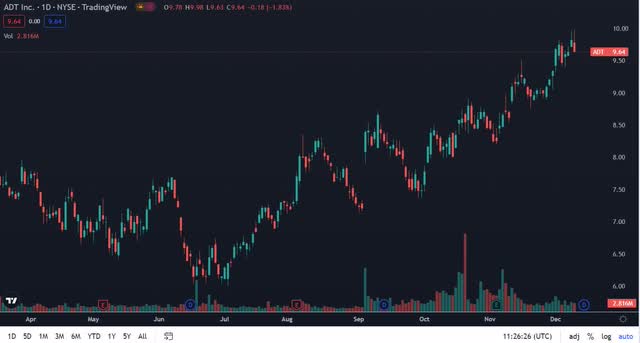RgStudio/E+ via Getty Images
ADT Inc. (NYSE:ADT) has been performing very well over the last year, led by its growing residential and commercial segments, while leveraging its partnership with Google for accelerating growth.
Management stated that it has basically laid the foundation to build on with the business now that it’s added State Farm as a partner, and plans on focusing on building upon that foundation in regard to its future performance.
Some macro-factors are positive for ADT, including an economy and interest rates that are favorable because people aren’t relocating as much, which has resulted in them retaining a record number of customers, as attrition has fallen.
Concerning supply chain, while it has slowed down revenue in the near term because of lack of parts available to commercial customers, because its competitors are facing the same supply chain constraints, its backlog is remaining strong because they’re no cancelling because competitors have the available parts to serve them.
So looking ahead, it appears ADT has a lot of tailwinds behind it heading into 2023, with Google Nest doing well, its partnership with State Farm just getting going, and favorable economic conditions that are resulting in low consumer attrition and a strong commercial backlog.
In this article we’ll look at its latest numbers, some of its promising segments, and how to think of the stock in light of its big upward run since July 2022, when it hit its 52-week low of $6.00 per share.
Latest numbers
Revenue in the third quarter was $1.6 billion, up 22 percent year-over-year. Excluding the solar acquisition, ADT revenue grew by 8 percent in the reporting period.
Recurring monthly revenue (or RMR) from its subscriber base increased to $372 million or 4 percent over the third quarter of 2021, a record in that category for the company. That was attributed to pricing power, improved customer retention and growth initiatives.
Adjusted net income in the reporting period was $83 million or $0.10 per share, compared to a loss of $54 million in the same quarter of 2021. Adjusted EBITDA was up 12 percent in the third quarter as a result of an increase in revenue and expanded margin.
Its commercial and small business (or CSB) segment generated revenue of $1.1 billion, up $75 million or 7 percent year-over-year. Growth in its monitoring and services revenue accounted for 5 percent of the increase in revenue in the quarter.
As a higher percentage of its customer base embraces its virtual service program it has driven down costs and lowered the number of higher-priced in-person visits by 26 percent in the third quarter of 2022, compared to the third quarter of 2021.
In its commercial business, revenue there was $314 million, up 12 percent from last year in the same quarter. This is going to be a significant tailwind in the near future as supply chain constraints work is alleviated. As mentioned earlier, this is a positive because its competitors are facing the same supply chain issues, so companies are staying with them and not cancelling orders.
The one negative for the company in the quarter was the performance of its Solar segment, which generated revenue of $179 million, with an adjusted EBITDA loss of $6 million, as a result of “installation delays associated with a third-party lender’s insolvency in the June quarter and cost inefficiencies from lower install throughput.”
While taking steps to improve margin, it’s going to take some time to right this segment, although over the long term, it should start to be a positive contributor to earnings.
As for free cash flow, that has jumped to $145 million, up from $62 million in the third quarter of 2021. That was attributed to low investment in subscribers and higher recurring revenue flow-through. Cash interest will remain a headwind with it expected to be about $20 million higher in the second half of 2022 than in the first half.
With its $700 million maturity due in 2023, the company entered into a new debt commitment letter of as much as “$600 million of term loans under a senior secured term loan A facility.” Combined with cash on hand the company will repay the $700 million maturity.
The State Farm partnership
The biggest news in the third quarter was the announcement that ADT had entered into a partnership with State Farm. The two companies will work together to leverage smart home technology against various home ownership risks.
State Farm has a customer base of over 14 million, and ADT will work on introducing its products and services in order to better serve customers while reducing net losses on the part of State Farm. That in turn will increase the customer base of ADT and boost revenue.
To further enhance the effectiveness of the partnership, State Farm has committed up to $300 million toward R&D, tech and sales and marketing. ADT management said the two companies already have teams working together on developing its first integrated offering, which is projected to be released sometime in the spring of 2023.
Also per the partnership, State Farm has taken a $1.2 billion stake in ADT, while at the same time having its COO Paul Smith appointed to ADT’s board of directors.
This partnership looks like one that has a lot of long-term potential for ADT, and it’ll be instructive to see how the first product does when released into targeted markets in 2023. The benefit to both companies is readily apparent, and it should be a significant tailwind for ADT.
Google Partnership
ADT’s partnership with Google is increasingly beneficial to the performance of the company, based upon customer responses to Google Nest products.
Demand for the branded product is much higher than the demand for the non-branded devices ADT has offers.
One example of that is the attachment rates associated with Google Nest Doorbell, which is over 50 percent above devices that aren’t branded.
Management noted that it expanded the number of devices it offered via Google Nest and found that there was a 30 percent increase in cameras per home versus its prior baseline.
Expanding upon its virtual service, ADT is scheduled to launch its ADT+ app and self-setup of its ADT product suite, which will include Google Nest offerings. The new app will be integrated with Google Nest video. Google and ADT are engaging in a joint marketing campaign that will launch in 2023, with Google contributing $50 million to it, with another $100 million available to invest in the initiative.
Google Nest has been a major reason behind increasing revenue and subscriber acquisition cost (SAC) efficiencies in the company.
Commercial business
ADT commercial would be a much larger contributor to the performance of the company if it weren’t for ongoing supply chain constraints. Revenues in the third quarter climbed 12 percent in the third quarter and are up 9 percent at the end of the reporting period.
With the supply chain constraints, installation backlog has increased by 25 percent to $445 million over the last year. Approximately $100 million of that is associated with delay in parts.
I think Commercial is not fully priced in at this time because there is little in the way of cancellations because its competitors are experiencing the same delay in receiving parts, so customers aren’t moving their business to other providers.
Since the backlog has resulted in stretching out the sales cycle, a lot of this is going to be pulled forward to 2023, which will add to its performance. It also points to the fact the numbers for ADT would have been even better if it had ample parts to service its Commercial orders. With some big wins with national accounts, high retention rates in the Commercial segment, and a record backlog that will be worked through in 2023, Commercial should be a strong tailwind for ADT over the next year.
Conclusion
ADT does have a lot of positive things going for it at this time. It competes in a market that has a lot of benefits coming from the current economic conditions, even with higher interest rates.
With its retail customers, the company is experiencing higher retention rates because of the lower number of people moving to new locations. That should continue on through 2023.
Management also said residential installations have been growing from quarter to quarter as its sales team becomes better at understanding and handling some of the new offerings associated with Google Nest. With an increase in investment in the partnership from Google, residential growth will probably accelerate going forward. Finally, with its Commercial segment the backlog and high customer retention rates will provide a nice boost in revenue that is being pulled forward from 2022 as a result of supply chain issues.
While Solar will be a slight drag on the company in 2023, it appears it may have the capacity to contribute more toward the end of 2023 and further out. Even so, the other segments should do more than well enough to offset Solar and generate solid returns over the next year.
In the near term, the biggest headwind I see is actually the success of ADT which has driven up its share price by more than 50 percent since July. With much of that probably being priced in at this time, I think the stock is probably due for a correction, assuming shareholders take some profits.
The things that I think will support the stock if it corrects will be the expected outperformance of its Commercial segment, ongoing contribution from Google Nest, and the growth that it should get from its partnership with State Farm.
Add to that the growing adoption of its virtual service, which is lowering costs, and the future of ADT looks bright over the long haul.
From now on, the company will focus primarily on the existing foundation it has laid, working on fully leveraging them to their fullest potential. That suggests lower inputs and a vastly improving performance over the next couple of years.



Be the first to comment